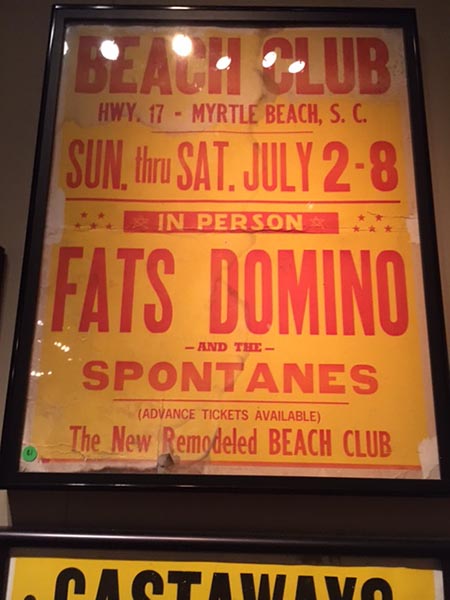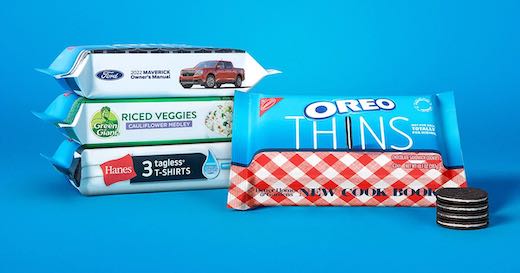Your Friday If People Only Had One-Inch Strides
The suggested terms for a person who has received two doses of a coronavirus vaccine include ‘recidivac’, ‘boxer’ (=one who has two jabs), ‘doppio’ (=a double espresso shot), ‘binoculated’, and ‘a complete prick’. (h/t @dontattempt)
— Quite Interesting (@qikipedia) July 29, 2021
Can’t Find a Thrill
A former, now retired contributor chimes in: “WHO KNEW? Fats Domino traveled to the NC shore for a performance...and based on the poster we saw @ the NC history museum, he was on stage with a bunch of Scitex color digital printing devices!”
Let’s see who gets that reference…

Or that Myrtle Beach is in S.C.
Could Be
What if UFOs are just billionaires from other planets?
— ?????? ?????????? (@tlhicks713) July 24, 2021
QR Goes Mainstream
You can tell that QR codes have entered the cultural zeitgeist when there is a New York Times story about them. As we all know, QR codes—which have been around since the 1990s and used occasionally on signage and in publications (Graph Expo Show Dailies used QR codes in printed editions to link to videos, for example), but really took off during the pandemic as bars and restaurants added touchless menu and ordering options.
Each table at Teeth has a card emblazoned with the code, a pixelated black-and-white square. Customers simply scan it with their phone camera to open a website for the online menu. Then they can input their credit card information to pay, all without touching a paper menu or interacting with a server.
A scene like this was a rarity 18 months ago, but not anymore. “In 13 years of bar ownership in San Francisco, I’ve never seen a sea change like this that brought the majority of customers into a new behavior so quickly,” said Ben Bleiman, Teeth’s owner.
Indeed, the National Restaurant Association said that half of all full-service restaurant operators in the United States have added QR code menus since the onset of the pandemic. “In May 2020, PayPal introduced QR code payments and has since added them at CVS, Nike, Foot Locker and around one million small businesses. Square, another digital payments firm, rolled out a QR code ordering system for restaurants and retailers in September.”
But there could be a dark side to QR codes.
But the spread of the codes has also let businesses integrate more tools for tracking, targeting and analytics, raising red flags for privacy experts. That’s because QR codes can store digital information such as when, where and how often a scan occurs. They can also open an app or a website that then tracks people’s personal information or requires them to input it.
As a result, QR codes have allowed some restaurants to build a database of their customers’ order histories and contact information. At retail chains, people may soon be confronted by personalized offers and incentives marketed within QR code payment systems.
… QR codes “are an important first step toward making your experience in physical space outside of your home feel just like being tracked by Google on your screen,” said Lucy Bernholz, the director of Stanford University’s Digital Civil Society Lab.
Of course, it may turn out that people don’t mind this.
These Shoes Were Made for Stalkin’
Woman Stalked Across 8 Websites By Obsessed Shoe Advertisement https://t.co/8VifKdbisM pic.twitter.com/qY37p3LQjA
— The Onion (@TheOnion) July 21, 2021
Graphene Goes Downhill
Was it a good week for graphene news? It’s always a good week for graphene news! Despite the oppressive heat in many parts of the country, ski season is almost here and graphene fans have a new development to increase performance, reduce weight, and improve toughness and endurance of skis. Skis with graphene-enhanced resin were tested last season and seem to hold up to the promise! (Alas, graphene cannot help increase the performance, reduce the weight, or improve the toughness and endurance of skiers.)
Going for the Gold
Hitting your assigned word count. https://t.co/8tD78pTP42
— Mark Harris (@MarkHarrisNYC) July 25, 2021
Not So Fast, Fashion
If you missed Wednesday’s Textile & Apparel Webinar, you should go check it out, but the topics that came up was the low pricing of garments—there is such a waste problem with fast fashion because clothes are so inexpensive and wear out so quickly that there often is little choice but to discard them. But what if clothing was reshored, industry workers were paid well, and prices grew accordingly—but a pair of jeans or a shirt could last 10 years? Would anyone be willing to pay extra?
On a related topic, there was a story in The Guardian this week that asked, “can you tell how ethical your clothing is by its price?” What is the production cost of a garment vis-à-vis its selling price, and how much of that goes to the workers who physically made the garment?
David Hachfeld of the Swiss NGO Public Eye, along with a team of researchers and the Clean Clothes Campaignsought to find out, but it is not an easy task.
It took several people six months, involved badgering Zara’s parent company, Inditex, over email, slowly getting limited information in return, and interviewing dozens of sources on the ground in Izmir, Turkey, where the garment was made. The researchers analysed financial results and trading data, and consulted with experts in pricing and production. It was, Hachfeld says on the phone, with dry understatement, “quite a huge project”.
Their research suggested that the biggest chunk of the hoodie’s retail price – an estimated €10.26 – went back into Zara, to cover retail space and staff wages. The next biggest slice, after VAT at €4.44, was profit for Inditex/Zara, at €4.20. Their research suggested that the textile factory in Izmir received just €1.53 for cutting the material, sewing, packing and attaching the labels, with €1.10 of that being paid to the garment workers for the 30-minute job of putting the hoodie together. The report concluded that workers could not have received anything like a living wage, which the Clean Clothes Campaign defined, at the time the report was released, as a gross hourly wage of €6.19.
The company claimed the research was inaccurate, but declined to point to any specific errors. “Fast fashion” has been enabled by super-cheap clothing prices, but, the article continues:
the correlation between price and ethics is knotty, to say the least. The conversation about sustainable fashion tends to be dominated by expensive designer brands: at Stella McCartney, for example, a wool-cotton jumper costs £925; at Another Tomorrow, each $520 sustainable viscose carbon-offset scarf neck blouse features a QR code in the label that outlines every stage of its “provenance journey”.
On the high street, many who proudly opt out of shopping at Primark or Boohoo for ethical reasons may be unaware that most reassuringly mid-priced brands don’t guarantee workers living wages or produce clothing without using environmentally harmful materials. A garment’s price is often more about aspiration and customer expectation than the cost of production.
So if you want to buy ethical clothing, what ca you do?
[fashion ethics comparison app] Good on You aims to “provide ratings for as many brands as possible, rather than simply promoting the most sustainable brands”. You could, for example, move from an ultra-rapid fashion brand to a more engaged high-street fast-fashion brand, which might not cost much more, but still could constitute progress.
Buying fewer, but better-quality, items might save you money overall and is the most consistent advice you will hear from fashion campaigners. “Buy the best quality that you can afford, perhaps in end-of-season sales or by buying a thick jumper in the middle of summer to wear the next winter,” says Hulme.
Why Fi
“why-fi enabled” is how i’m going to call all the @internetofshit devices that don’t need to have wireless internet capabilities. like washing machines.
— EricaJoy (@EricaJoy) February 21, 2020
Package Protection
Are you tired of your kids nicking your stash of Oreo cookies? The makers of Oreo Thins (the adult version of the classic Oreo cookie)(…what’s an adult version of a cookie?) have partnered with other brands to create Oreo Thins packaging that actually has other product logos on it. Says Adweek:
it partnered with brands that have seemingly nothing to do with Oreo: Ford, Green Giant, Hanes and Better Homes & Gardens.
The limited edition wrapping makes a package of cookies look like a vehicle owner’s manual, frozen vegetables, plain white t-shirts or a classic cookbook. That way, parents can slip sweets into the glove box, sock drawer, freezer or bookshelf and the kiddos will be none the wiser.

Of course, the kiddos just have look at the top of the packaging and the jig is up. And if someone was actually looking for a package of T shirts they’re going to be mighty disappointed.
Nuts to That
If you’re trying to lose weight, a handful of almonds is a great thing to angrily throw at your reflection in the mirror.
— Grey DeLisle-Griffin (@GreyDeLisle) July 27, 2021
Run, Robot, Run
We all know the robot apocalypse is coming. And the burning question you may have is: could I outrun a killbot, should the need arise (which it almost certainly will)? Well, if Oregon State University’s bipedal killrobot Cassie is any indication, most anyone could even outwalk it. Says Gizmodo, Cassie did a 5K (3.1 miles) in 53 minutes.
Cassie has been around for a while and is the brainchild of Agility Robotics—a spinoff of OSU. The significant thing here isn’t so much the speed in which Cassie completed the 5K. The average able-bodied human, for instance, can walk a 5K in a similar amount of time or less, and most beginner runnerscomplete that distance in 30-40 minutes. (Even in OSU’s video, you can see folks keeping up with Cassie while walking.) The impressive thing is Cassie was able to “run” that far untethered and on a single charge.
Running is, biomechanically speaking, pretty complex. There are whole sites dedicated to dissecting running gaits, but most people just run instinctively. Recreating that ability in robots—especially bipedal robots—is difficult as it requires something called “dynamic balancing”, or the ability to shift positions in motion without toppling over. The team says Cassie was able to teach itself how to make subtle adjustments while moving thanks to a “deep reinforcement learning algorithm.”
The purported uses of bipedal robots are for the benefit of humankind, at least initially:
OSU envisions bipedal robots will one day handle logistics work, such as package deliveries, but also help people in their homes. “In the not very distant future, everyone will see and interact with robots in many places in their everyday lives, robots that work alongside us and improve our quality of life,” said Hurst.
Until they tire of it…
Watch Cassie in action to give you an idea of what might be the last thing you’ll ever see:
One Small Step
I’d like to think that Neil Armstrong would see the importance of my own 3am mission, “Jake Gyllenhaal how tall” https://t.co/cfReAFozIb
— Daniel Kibblesmith (@kibblesmith) July 27, 2021
A Leg Up (and Down)
You know how it is: you break your leg and the biggest downside of being cast-bound is that you can’t hop about on your pogo stick. Tough break—literally. Well, mope no more. Via the appropriately named Boing Boing, you can make your rehab more extreme with a pair of Pogo Stick Crutches, the brainchild (if that’s the word to use) of Unnecessary Inventions designer Matty Benedetto.
Unhappy Reunion?
"We meet again, old woman, but this time the advantage is mine" https://t.co/aX9svAEFG2
— Jason (@longwall26) July 26, 2021
Ceci N’Est Pas Un CAPTCHA
Here’s an idea to really test whether someone accessing a website is human: philosophical CAPTCHAs.

If you’re René Magritte, you go straight to Skip. There is also a Ship of Theseus CAPTCHA. Take that, robot!
Over 60s
Just heard the song "Born To Be Wild"
— Ron Sexsmith (@RonSexsmith) July 29, 2021
in an Applebee's commercial!
If that ain't the final nail in the 60's
I don't know what is.... RS
Tennis Anyone?
It’s time for a new series of The Unbelievable Truth, the BBC Radio 4 comedy panel game, and another interesting bit of trivia. In this case, how tennis balls became yellow, which was largely thanks to British broadcasting legend Sir David Attenborough. When tennis was first invented, the balls were white (or occasionally black). David Attenborough was controller of BBC2 in the late 1960s, and pushed the government to allow the network to be broadcast in color, which was granted in 1967. So in 1967, Wimbledon was broadcast in color for the first time. Tennis 365 takes up the story.
However, the sport continued to use white tennis balls, but the introduction of colour television meant it was harder for viewers to pick up the flight of the white ball or when it clipped the white lines.
It forced the International Tennis Federation to look at alternative colours and they approved fluorescent yellow known as “optic yellow” in 1972, but it took Wimbledon another 14 years before they finally saw the light.
“The ITF introduced yellow tennis balls into the rules of tennis, as research had shown these balls to be more visible to television viewers. Meanwhile Wimbledon continued to use the traditional white ball, but eventually adopted yellow balls in 1986.”
Now you know.
Signs of the Times: Channel Typos
wait for it pic.twitter.com/Yzlxv49DWH
— blaine capatch (@blainecapatch) July 28, 2021
The Last Straw
Do you like drinking from a straw, but want to avoid disposable plastic straws? Are stainless steel straws impractical or dangerous? (For example, while driving, on a turbulent plane, on a roller coaster.) Well, why not try a silicone straw that unzips for easy cleaning? Via Core 77, they are sold by Uncommon Goods, are dishwasher-safe, and go for $10 for a three-pack.

These bright, BPA-free, platinum-grade silicone straws are the answer. The set of three actually unroll for easy cleaning by dishwasher or hand, and yet are leak-proof—making it easy to bring them everywhere.
But Are they Perefct?
Krispy Kreme is selling Xbox doughnuts https://t.co/YnWvoHsvEx pic.twitter.com/q8syDMMfTZ
— The Verge (@verge) July 28, 2021
French Fried
The usual answer to the question “Would you like fries with that?” is “sure”—but be careful if you are at Serendipity 3, a restaurant in Manhattan, as those fries will set you back $200, as per this Reuters headline: “New York's $200 french fries offer ‘escape’ from reality.” And solvency. “The restaurant Serendipity 3 already claims world records for the most expensive burger ($295) and ice cream sundae ($1,000).” And the Guinness Book of World Records has added “most expensive french fries” to their claim to fame. Could they really be that good?
The Crème de la Crème Pomme Frites start out as Chipperbec potatoes. They are blanched - or scalded - in vinegar and champagne. Then they fry in pure goose fat, not oil, and not once but twice, so they are crispy on the outside and fluffy on the inside. Sprinkled with edible gold and seasoned with truffle salt and truffle oil, they are served on a crystal plate with an orchid, thin-sliced truffles, and a Mornay cheese dip. The sauce, too, is infused with truffles, a rare seasonal mushroom.
“Edible gold”?! Oh, come on. “There is an eight- to 10-week wait list for the fries.” OK, then.
Point of Know Return
In the early 80s, a Midwest band was attempting to stay relevant with an album inspired by a very successful band made up of LA session players. But as they drifted further and further from the mark, their producer had to say, “Kansas, I don’t think we’re in Toto anymore.”
— Berton Averre (@Averre13) July 27, 2021
Wheel of Misfortune
Who among us has not wanted to run on water all the way from Florida to New York? (Actually, it’s just basic instinct that makes us want to run from Florida to New York at any time on any conceivable surface.) But Reza Baluchi actually attempted it, having constructed what can only be likened to a large hamster wheel, but which he refers to as his “bubble.” As the BBC relates, he wanted to try to run (or perhaps roll) 1,000 miles north for charity, but things did not go well, and he ultimately washed ashore some distance south of where he had started. “Mr Baluchi encountered ‘complications that brought him back to shore,’ and was ‘safe with no injuries,’ Flagler County Sheriff's Office said.” He has tried before. “In 2014 he had to be rescued from a similar contraption near St Augustine, and then two years later he again had to be rescued off the coast of Jupiter, near Palm Beach in Florida.”
Pump Up the Jam
Car Rolls Up To Stoplight Blasting Google Maps Directions https://t.co/pmXpVZySyw pic.twitter.com/lY9yzGh0PF
— The Onion (@TheOnion) July 18, 2021
Where Is Thy Sting? Oh…
Last year, the murder hornets were all the rage (well, not really, but a few of them, were found and confined to the northwest corner of Washington state), and now this year…prepare for…cicada killer wasps! Not to be confused with our old friends the murder hornets, the cicada killer wasps, says National Geographic, are generally harmless unless you are a cicada. Indeed, the solely prey on cicadas, although not the periodical species such as Brood X that plagued the mid-Atlantic region earlier this year, but rather the everyday cicadas that hatch every year like normal insects.
Despite their large size and bright yellow and brown coloring, cicada killers are harmless to humans—they’re “gentle giants of the wasp world,” Schmidt says. Male cicada killers don’t sting, and, unlike Asian giant hornets, female cicada killers avoid people and rarely deploy their stingers. You’d actually have to handle them to ever be in danger.
Comforting to know.
Maybe Roscoe Conkling?
I want to meet the 5% of Americans who not only have an opinion of Chester A. Arthur but have a strongly hostile opinion of Chester A. Arthur. https://t.co/jV4FxWjt9f
— Kevin M. Kruse (@KevinMKruse) July 27, 2021
This Week in Printing, Publishing, and Media History
July 26
1502: German printer Christian Egenolff born.
1856: Irish playwright, critic, and Nobel Prize laureate George Bernard Shaw, born.
1887: Publication of the Unua Libro, founding the Esperanto movement.
1894: English novelist and philosopher Aldous Huxley born.
1928: American director, producer, screenwriter, and cinematographer Stanley Kubrick born.
1989: A federal grand jury indicts Cornell University student Robert T. Morris, Jr. for releasing the Morris worm, thus becoming the first person to be prosecuted under the 1986 Computer Fraud and Abuse Act.
July 27
1866: The first permanent transatlantic telegraph cable is successfully completed, stretching from Valentia Island, Ireland, to Heart's Content, Newfoundland. They could now communicate with each other to their heart’s content.
1940: What’s up, Doc? The animated short A Wild Hare is released, introducing the character of Bugs Bunny.
1938: Gary Gygax, creator of Dungeons & Dragons, born.
July 28
1844: English poet Gerard Manley Hopkins born.
1866: At the age of 18, Vinnie Ream becomes the first and youngest female artist to receive a commission from the United States government for a statue (of Abraham Lincoln).
July 29
1805: French historian and philosopher Alexis de Tocqueville born.
1818: French physicist Augustin Fresnel submits his prizewinning “Memoir on the Diffraction of Light,” precisely accounting for the limited extent to which light spreads into shadows, and thereby demolishing the oldest objection to the wave theory of light.
1953: Canadian musician Geddy Lee (né Gary Lee Weinrib) born.
1958: U.S. President Dwight D. Eisenhower signs into law the National Aeronautics and Space Act, which creates the National Aeronautics and Space Administration (NASA).
July 30
Both English novelist and poet Emily Brontë (1818) and English singer-songwriter and producer Kate Bush (1958) born.
1909: English historian and author C. Northcote Parkinson, coiner of “Parkinson’s Law,” born. He would soon grow to fill the entirety of his crib.
1932: Premiere of Walt Disney’s Flowers and Trees, the first cartoon short to use Technicolor and the first Academy Award-winning cartoon short.
2006: The world’s longest running music show Top of the Pops is broadcast for the last time on BBC Two. The show had aired for 42 years.
July 31
1703: Author Daniel Defoe is placed in a pillory for the crime of seditious libel after publishing a politically satirical pamphlet, but is pelted with flowers.
1790: The first U.S. patent is issued, to inventor Samuel Hopkins for a potash process.
1919: Italian chemist and author Primo Levi born.
1965: British author and creator of Harry Potter J. K. Rowling born.
August 1
1774: British scientist Joseph Priestley discovers oxygen gas. (What had everyone been breathing before that?)
1819: American novelist, short story writer, and poet Herman Melville born.
1965: Frank Herbert's novel Dune was published for the first time. It was named as the world’s best-selling science fiction novel in 2003.
1981: MTV begins broadcasting in the United States and airs its first video, “Video Killed the Radio Star” by The Buggles.
1981: American author, playwright, and screenwriter Paddy Chayefsky dies (b. 1923).















Discussion
Only verified members can comment.